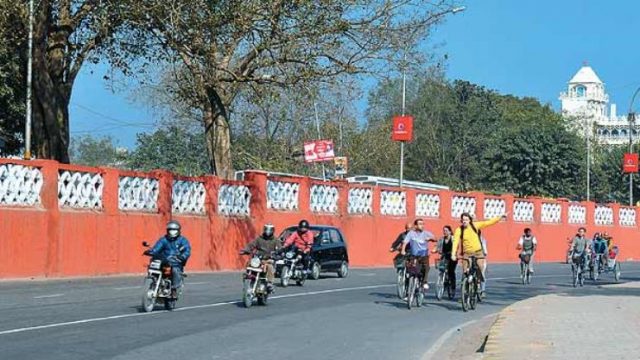“Arre cycle walon ko rasta do, yeh to paanch baje se chal rahein hai!” The exclamation is only one of the many, all good-natured, that we encounter as we tackle the alleyways of Old Delhi. In the lead is the six-foot plus figure of Jack Leenaars, who has begun DelhiByCycle. The South Asia correspondent of the Dutch daily De Telegraaf, Jack has been living, and cycling, in the city for the last five years. Over that time he has developed an intimate knowledge of its sidelanes and byways, something that he decided to put to good use after he went on a similar bicycle tour organised by a Dutchman in Bangkok.
It’s a brilliant idea for Old Delhi, where the roads and crowds make navigation by car almost impossible, and which is spread over far too large an area to be easily covered on foot. We also start out relatively early to avoid the rush. The meeting point is the cycle/motorcycle stand on the Ajmeri Gate side of the New Delhi Railway Station. We choose our bikes — a unisex version of the ever reliable Atlas cycles — and make sure the seats are adjusted for comfort. Jack gives a few crisp instructions. “I’ll be in the lead and Mukesh, my assistant, will bring up the rear. Remember to obey traffic rules — and yes, for those who are wondering, there are traffic rules. Don’t jump the red lights, stay on the side of the road, signal with your hand when you’re turning, and use the bell.” And we’re off.
The route goes through G.B. Road (Shradhanand Marg). Jack points to the upper storeys of the buildings. “This is the red light area, although there is nobody around at this time. I did a story here and it’s interesting in the evenings, with the women in the kothas on one side, and men hoping to get lucky on the other side of the road.” At this time in the morning, though, it’s just a normal place, quiet except for those moving out on their way to work. This makes it safe for women as well, and the inherent gallantry of the people asserts itself.
This is the heart of the experience. It’s not so much a guided tour, as getting an idea of the alleyways and the people who live there. Near LalKuan, half the road is dug up; every 20 yards or so we glimpse a beautiful piece of stone or woodwork in the old buildings, and all along the way, we hear wisecracks from the residents, “Arre, it’s a cycle race… the bicycle in the front is an import, all the rest are desimaal…” We stop for a breather at the lovely Fatehpuri Masjid, and then swing towards Khari Baoli, the first wide road that we run across, with its huge market swamping our senses. First the smell of the flower market assails us and then the strong smell of spices overpowers the fragrance of flowers. We hang a right into another alley and come out near a South Indian temple, with a statue of Mahatma Gandhi just ahead of it.
“We’re now going to pass into Civil Lines,” Jack informs us. This is the area where the British moved out to after the 1857 uprising. It’s a lovely area, with wide streets but we keep a sharp eye out because the cars are faster. Along the roads we see signs proclaiming that the residents are IAS officers, and go past the Lt Governor’s residence. We take a swing through the driveway of the Oberoi Maidens, and then into Maharaja Lane right next to it for “high tea with biscuits” at a discreet little dhaba.
This is the halfway point, as we turn back here towards Old Delhi once again, making our way past St Stephen’s Hospital around the Town Hall plot, catching a glimpse of the Old Delhi Railway Station to emerge in ChandniChowk. It’s getting a bit more crowded but we negotiate NetajiSubhas Marg easily enough, cycling past the Red Fort, before turning in towards the Jama Masjid. With all the smell of food, you’re bound to be hungry — and Jack has timed this perfectly — because he takes us directly to Karim’s for a morning meal — in this case nihari roti.
After a much-needed repast, we cycle — or try to — through the immensely crowded Chitli Qabar Road, cracking jokes with a rickshaw-wala and making sure we don’t stumble into the tubload of goat’s brains being sold along the street. We pop up near Hajj Manzil, and wind back into Himmatgarh — with its beautifully detailed architecture visible in almost every doorway — and the smell of kababs replaced by the scent of kachauris. And before you know it, we’re winding our way back to Ajmeri Gate — our three-hour tour over and with a vision of Delhi we’ve never seen before.
DelhiByCycle tours are conducted by Jack Leenaars (9818981194, delhibycycle@gmail.com). The charges are Rs 950 per person, with a maximum of six people per tour; special rates for a weekday tour for a group of six is Rs 600 per person. Bicycle, tea and snacks are provided. The tour begins at 7.15am in the summer (an hour later during winter), starting out from Ajmeri Gate and lasting approximately three hours.




